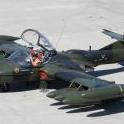Leaderboard
Popular Content
Showing content with the highest reputation on 07/31/2015 in all areas
-
4 points
-
Never going to happen in fighters. Yeah yeah the FAA is going to "require" it by 2020, but I can not ever see this being funded considering what is NOT funded in "legacy" platforms. Fighters are not airplanes, they are war machines. Just like a tank that doesn't have turn signals, airbags and rear view cameras, I can't see the DoD letting the FAA drive how we spend money on hardware/software on fighters. Yes I realize the FAA and ATC thinks we would all run into each other if it were not for them, that is simply not the case Yes, the current mishap in SC is ONE recent data point to the contrary. But are we really not going to fund a system that enhances combat capability in order to fund an ADS-B "upgrade" No freaking way. Are we going to GAB a jet because ADS-B isnt working...no way. DoD and FAA will play chicken and the DoD will win. You fly an airplane by LOOKING OUT THE WINDOW....not down at some iPad looking thing telling you where "everyone" is.2 points
-
Mods, I performed a search, but did not see any topics covering the above process, and I wanted to give my $.02 on how my claim process worked. 1. I separated from AD in late 2014, and had attended TAP classes in September of that year. When asked by the briefer if any of us planned on filing a disability compensation claim, almost none of the 40 of us raised our hands. He offered to look at each of our medical records if we made an appointment with him and encouraged us to do so. 2. I ordered copies of my medical records from my base's clinic immediately after the TAP class was over for the day. In the AF, your medical records will typically take 6-8 weeks to be copied or put on a CD in PDF format. I recommend doing this as early as possible in the process, and I will explain why in paragraph 5. 3. There are many Veteran's Service Organizations (VSOs) out there, and they all have a common goal to fight for Veterans. I chose the Disabled American Veterans (DAV) because after careful research, they give back the most to Veterans, and are a powerful lobbying organization. 4. When I made my appointment with the representative who briefed at my TAP class, he went through my records and helped me fill out all of the proper forms. I remember needing my marriage certificate, birth certificates for my family, SSN cards, and finally, a bank account number as well as the routing number of your bank. 5. I filed my claim in early December before I separated at the end of the calendar month in 2014. This was incredibly important because you will either file under the Benefits Delivery at Discharge (BDD) or the QuickStart Program. If I had gotten my medical records earlier, I would have been able to have my VA rating (if anything in my records warranted it) on my discharge date. Unfortunately, I was not eligible for this program as there was not enough time to get my VA exams completed. Fortunately, my claim decision was made in April 2015, which was only four months after filing under the QuickStart Program. If you wait months or years later, then your claim could take anywhere between 1-2 years just for an initial decision to be made. 6. I had a handful of people who I really admired and respected while in the AF. One common theme every single one of them said to me was to make sure everything was documented in my medical records. I'm thankful to this day that I took their advice. 7. Some helpful websites: http://militarydisabilitymadeeasy.com/index.html http://www.benefits.va.gov/warms/bookc.asp#a http://www.dav.org1 point
-
Hollywood is on top of it, they will set us straight. And that will become the truth. Out1 point
-
1 point
-
No, just no. Also, before everyone takes out their "jump to conclusions" mats, why not let the investigators do their job and wait until the report is released.1 point
-
1 point
-
Mark1 is just out of his element. No need to get overly upset. I can't deny that his motivation is justified, and I know it's all well-intentioned. However, he's way out of his lane to suggest that the merits of ADS-B for the Viper outweigh already planned and pipelined developments to the F-16 avionics suite. You see, there are a couple problems that jump out at me right away when it comes to this: 1. The MMC (modular mission computer) on the Viper has been running on fumes for years. We're talking about 1980s technology attempting to process WAY more code than it was designed for, and the "brain" of the jet can barely keep up now with the level of information exchange that is supposed to happen on the battlefield. We have ALREADY overtasked that computer just to keep it "combat compliant" with what's expected of a modern pointy-nose asset. Yes, Lockheed is part of the problem, as any physical MMC upgrades are going to come at a hefty cost that we're not willing to pay. I'm sure ADS-B could be stand-alone (mostly) in the Viper, especially in the case of an "out-only" installation, but that system is still going to have to talk to the nav gear in the jet. The goddamn EGI already has issues, and I'm sure one more element in the equation ain't going to help. 2. The way a Viper is wired (literally, the fucking WIRES for components) is a complete shit-show. In the Viper, you have a 1990s era information exchange architecture that can't handle more data. Period dot. Viper CAPES might have helped this, but we won't get that because: money. 3. The Viper is a SEAD asset, and that means it carries gear that's sensitive to EM interference. This might come as a surprise to some, but you can't just slap a gizmo on a Viper (or anything) and expect it to work the way it did before unless there's a shitload of testing and reprogramming of the systems (and associated computing architecture) that are designed to listen to beeps and squeaks. Like running a vacuum cleaner on the same circuit as a cathode-ray (old school) TV, the picture ain't going to be clear. All this can be tested and adjusted for via engineers, but realize that the cost of a new piece of gear in a SEAD airplane is much more than just the per-unit cost of the electronics + labor. Thus, if 2020 is the implementation deadline, I'm going to go out on a limb and say that there's no fucking way we are anyway close to the contracting / developing / testing / implementing timeline. Especially with Lockheed Martin. And: With ADS-B not being required for aircraft operating in class E airspace below 10k', I can't think of a Viper-included mid-air (or near mid-air) in recent history where this would have helped. To whit, it's worth mentioning that the Viper isn't the only 4th generation fighter platform with these issues. I talked to some light Eagle guys who wanted to add a Sniper capability (A/A only) to their jet, but didn't have the computing power to make it happen. Last I heard, they were asking the engineers to borrow processing time from their DVR system to run the Sniper Pod. That's where we're at now w/4th generation fighters, boys.1 point
-
Gents, Thanks for the candid comments and perspective. Getting the views of military pilots that also own an aircraft is very helpful to my understanding of the problem. There is a ton I don't know about ADS-B, and am trying to get up to speed quickly. Much appreciated.1 point
-
Brabus, I'm guessing you are somewhat unfamiliar with NextGen. It isn't just for civilian Joe. Or civilian Huggy. And I get the fact that you're an ACC-trained killer and "anything else is rubbish". But the reality is that the USAF operates in American airspace as well as combat zones. And the FAA regulates American airspace. And whether you or COMACC likes it or not, it is going to be a fight for the next 53+ months if the AF continues to push back on this. The prioritization of "what keeps you alive in combat" has never been even close to perfect. That's why, instead of spending more time in the vault, you spend that time doing CBT's, SARC briefs, PT tests that measure nothing meaningful, and the myriad of other queep that is driving mission-oriented people from many facets of the military. But I digress. I certainly don't know how this ADS-B issue will play out. But based on the FAA's stance coupled with the fallout from the F-16 mid-air, I personally wouldn't bet it would be "a long time" before you see it.1 point
-
Great discussion going on here. Let me add an alternative perspective. They said it wasn't possible to arm RQ-1 with Hellfires. Fortunately others in USG disagreed. They said you shouldn't arm UAVs and employ lethal fires without a fighter pilot in the seat that understood CAS and fires, so only fighter pilots should fly UAVs. They said only pilots had the airmanship required to fly UAVs. They said unless you went to pilot training and learned about airspace, radio calls and instruments, you couldn't and shouldn't fly UAVs. They said a fighter pilot was too valuable to fly UAVs, that it was easy, and only the worst pilots should fly them. They picked the pilots they didn't want in their squadrons to go to UAVs. They decided that we should fly RPAs from remote locations, despite the fact you could fly remote split operations from anywhere in the world, including in major metropolitan areas where families would be happy to live. They realized there was nothing unmanned about these UAVs and changed the name to Remotely Piloted Aircraft. They killed UCAV development because they think a pilot must be in the seat, even when the pilot is the limiting factor in the aircraft. They think the next generation bomber should be manned. They decided the only way to keep pilots flying RPAs relevant was to create a companion aircraft program so RPA pilots could fly real aircraft and stay in touch with real flying, but this was not feasible because flying RPAs is not an easy part time job and there is no time. They thought it would be ok assure pilots they would go fly RPAs, then return to the cockpit, with no intention of changing the manning or accessions to actually honor that promise. They told us that 18Xs could not fly RPAs. They told us it would take years to figure out how to train non-pilots how to fly RPAs. They told us nobody would volunteer to fly RPAs. They told us the bonus for RPA pilots should be less than the bonus for real pilots. They decided that RPAs were easy and marginalized the employment of lethal weapons in combat. They actually think the RPA pilot guides the AGM-114 or GBU-49/12 to the target. They denigrated the RPA mission and those who conducted the mission, regardless of how much the joint force and civilian leadership value RPAs. They think enlisted airmen cannot fly RPAs, despite direct evidence of outstanding Army enlisted and warrant officer performance. They did not think auto takeoff and landing was a valuable capability worthy of investment, and preferred to crash aircraft during takeoffs and landings due to pilot error and insufficient training at a staggering rate, while the Army successfully employs auto takeoff and landing with a near perfect mishap prevention rate. They decided that the phrase "permissive ISR" would be used to discredit RPAs by pushing the narrative that they were not able to operate in denied airspace, while avoiding the same conversation with mobility, tankers, C2, and satellites. They forgot that we may have missions when manned aircraft will not be allowed to fly and that RPAs may be the only access we have to non-permissive environments. They developed the phrase "Pred Porn" to delegitimize the FMV value to Ground Force Commanders, Joint Force Commanders and Senior Civilian Leaders. They do not understand how RPAs integrate multi-source intelligence to accomplish national level objectives. They decided "Combat Time" for RPAs employing lethal fires in close proximity to friendly forces was not combat, but orbiting a combat support aircraft near a combat zone, with no threat of enemy fire or additional danger, was worthy of "Combat Time". They decided combat support aircrew were eligible for Air Medals, while in no immediate danger from enemy threats, while RPA crews conducting actual combat missions were only eligible for Aerial Achievement Medals. They failed to recognize that there may be situations where manned aircraft may be denied access to airspace, not only because of the threat, but because of political considerations and the risk of being shot down in denied area. They think a pilot who practices killing people but never performs this skill in combat is more of a warrior than those who actually kill people. They decided to not fund RPAs, after reducing the number of CAPs in the first few years, they planned to go to zero CAPs so they could commit the money to other priorities. They decided to keep the RPA crew ratio below a sustainable level, crushing OPSTEMPO, morale and sustainability. They let RPA crewmembers separate early to meet short term manpower reduction goals, before their commitment was up, even from squadrons where the pilot and sensors were undermanned in that unit. They decided to not invest in RPA technology, stating and I no shit quote "every dollar we spend on MQ-9s is a dollar we can't spend on F-35". They are telling us they can't fix the current RPA crew shortage. They are telling us they don't know how to improve morale. They are telling us RPAs are not important to our nation's defense. They think pilots with no RPA experience are qualified to command RPA squadrons, groups and wings. They use the phrase CT/COIN to marginalize the current fight and emphasize the importance of near peer competitor threats. And they will continue to recommend we stop flying RPAs so we can invest in more important weapon systems and more important missions. When will we stop letting them make these bad decisions and give this bad advice? When have they lost enough trust and confidence of our joint partners and civilian leaders? When will we realize that "they" are actually the problem and that we should not value their recommended solutions? It is time to get ISR out of ACC, to let ACC focus on what they value and what they are the best in the world at, and most importantly, stop ing up RPAs.1 point
-
1 point
-
The ignornace is on both sides. I've seen it firsthand on both end; in fact, just dealt with it with a military A-10 guy a number of months back, as well as a civilian person; both on airspace issues that both were ignorant of.1 point
-
I must have missed the paragraph in the commissioning oath that prioritized your safety over that of the people behind the document that you swore to defend. I always thought the entire point was that you voluntarily sacrificed a level of your own personal safety in order to provide it for the citizens you serve. That could take the form of forgoing the latest and greatest RWR variant in favor of something that makes you less of a hazard in civilian airspace. However, we wouldn't want to go out of our way to provide a 'service' to civilian joe [or equivalent slightly belittling term for your employer]. That's just not what the military is in the business to do. Get over yourself. P.S. If it's any consolation, your MWS hasn't seen combat in well over a decade and most probably never will again. Re-purposing funds away from combat systems and towards FAA/ICAO airspace compatibility probably increases your survivability.-5 points
-
1. An aircraft with limited visual signature moving at 400kts is a (not 'the') hazard, just as every other thing in the sky is a hazard. That's a general comment made with absolutely no reference to the incident that spawned this thread, so unwad your panties. 1a. I made zero reference to any mid-air in my previous post. I did reference a piss poor attitude for a public servant, and not much else. You want a statistically significant demonstration that mil aircraft are a hazard to GA? Reference the link provided on page 1 of this thread about a fatal mid-air between an F-16 and a GA aircraft over South Carolina. Regardless of fault, had the military aircraft not been in that airspace at that instant, there would have been no incident. That's about the definition of a hazard. 1 vs. 0 is always statistically significant as it indicates an event is not impossible. Day 1 - Intro to Statistics. Nailed it. 2. I have no SA on how acquisitions works? I could put you in touch we a few guys at BIG SAFARI that might disagree with you. You seem to be under the impression that I'm advocating for ADS-B in the F-16. I am not. To form an opinion on the matter I would have to weigh that course of action against its opportunity cost, which would take time and effort...time and effort that I would demand compensation for. What I am advocating is that you lose the self-centered dismissive tone when someone (not me) suggests an addition to your aircraft that improves its integration into civilian airspace...inevitably at the expense of something else. Because, once again, your precious safety in combat (if you ever see it) does not take priority over non-squawky, non-talky, GA pilot Cleetus. 3. Great. I didn't reference ADS-B for the F-16 in my previous post so I'm sure he makes a bunch of great points that don't conflict at all with what I had to say. 4. No doubt your unit showed you their 'everybody gets a trophy' here's what we've contributed, feel-good video when you in-processed. Every unit has one...from the cooks on up. And they're important. Everybody wants to feel needed. Nevertheless, combat requires the exchange of force by at least two parties. From the F-16 perspective, it's been a one sided affair since the Balkans wound down...well over a decade ago as I stated. Yes, the F-16 has intervened in the combat of guys on the ground in OEF/OIF and elsewhere since then, but only from the comfort of a completely different non-combat environment. And that's fine. It's a necessary contribution and the extent of most members of the AF participation. There's no shame in it. In fact it's quite worthy of a level of pride. Bottom line: the F-16 has, as of late, been shoehorned into the fray just to 'get in the game' in many places at the expense of (relative) poor coverage for guys on the ground and more tanker orbits, but they've contributed quite a bit...from outside a combat environment. Don't bother to bring up Libya. You and I both know the details and it doesn't qualify. I'd possibly grant you a few days in 2003 but it's splitting hairs. 5. Cool Although it was off the cuff and I didn't intend for it to be factual, I'd bet more likely than not that investing in equipment to improve integration into civilian airspace would actually increase survivability in the F-16 over putting that money into combat related systems. Before your panties get all wadded up again, I am not suggesting we do that...but I do think that more likely than not it would hold true. Then again, your survivability is not the priority.-6 points











